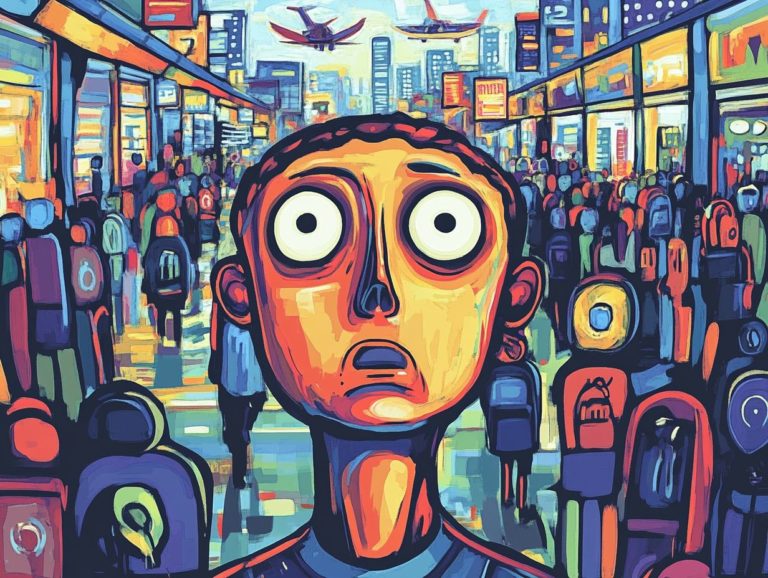How to Navigate Public Transport Abroad?
Navigating public transport in a foreign country can be exhilarating. However, it can also feel intimidating. Understanding ticketing systems and local customs will significantly enhance your journey.
This guide provides essential tips for researching your destination, carefully planning your route, and effectively utilizing maps and timetables.
You ll find practical advice on staying safe and overcoming language barriers. By the end of this guide, you ll be ready to maximize your public transport experience abroad with confidence!
Contents
- Key Takeaways:
- Understanding the Public Transport System
- Researching Your Destination
- Planning Your Route
- Tips for Navigating Public Transport
- Final Thoughts and Recommendations
- Frequently Asked Questions
- What are the different types of public transport typically available in foreign countries?
- How can I plan my route using public transport in a foreign country?
- What is the best way to purchase tickets for public transport abroad?
- How do I know which mode of public transport to take?
- What should I do if I get lost or miss my stop while using public transport in a foreign country?
- Are there any safety precautions I should take while using public transport abroad?
Key Takeaways:
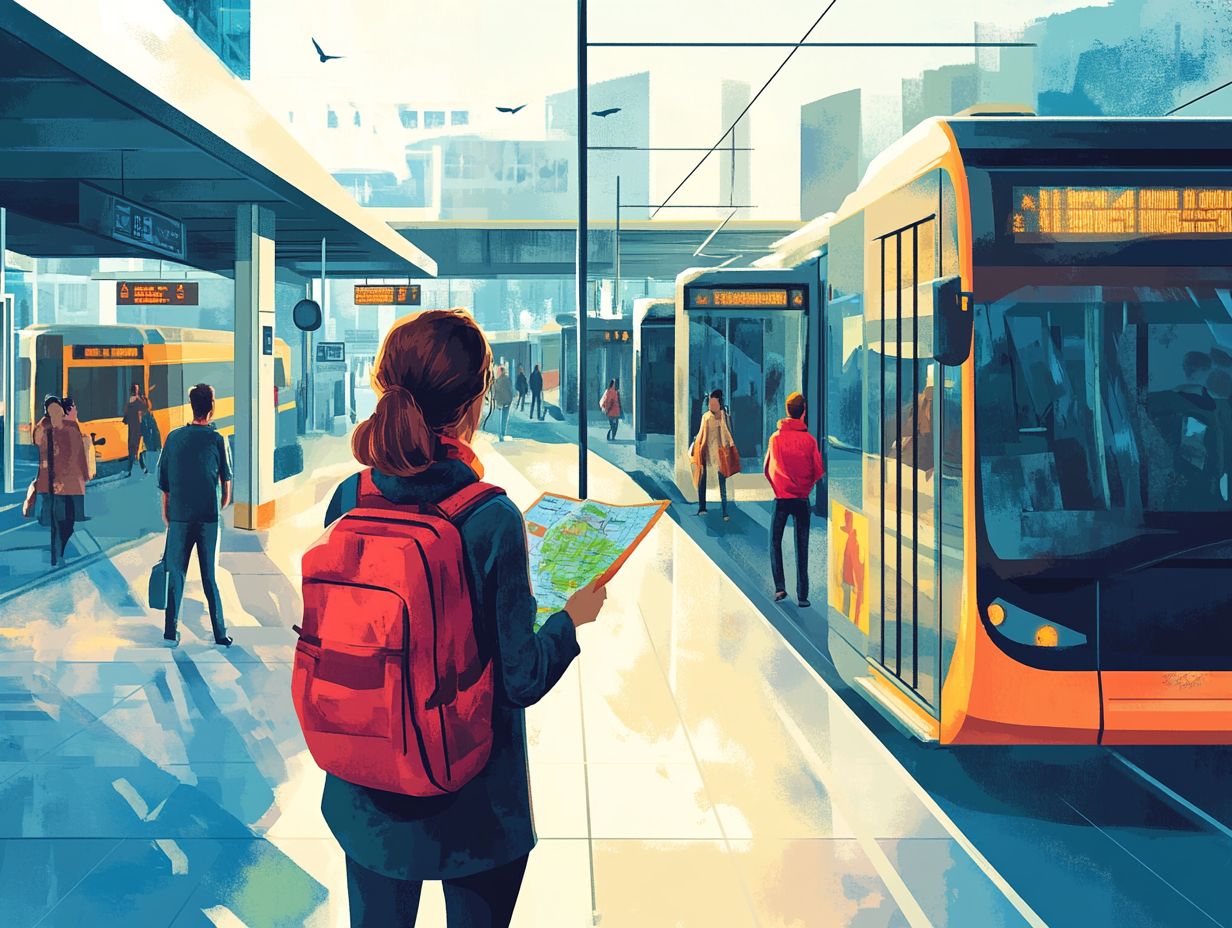
- Familiarize yourself with the different types of public transport and ticketing systems in your destination to save money and make your journey easier.
- Do thorough research on transportation options and local customs before your trip to ensure a smooth and culturally respectful experience.
- Plan your route using maps and timetables. Consider alternative routes and transfers to reach your destination efficiently. Stay safe, aware, and prepared for potential language barriers.
Understanding the Public Transport System
Japan’s public transport system is celebrated for its efficiency, cleanliness, and punctuality, making it the perfect choice for travelers exploring the vibrant cities of Tokyo, Kyoto, and Osaka. With options ranging from trains and subways to buses, navigating this intricate network can elevate your travel experience.
The Japan Rail Pass is an attractive option, granting you unlimited travel on many rail lines ideal for visiting historical sites and cultural treasures across the country. However, familiarizing yourself with local customs, ticketing systems, and etiquette is essential to avoid culture shock during your journey.
Types of Public Transport
In Japan, you ll discover a diverse public transport system that includes trains, subways, buses, and even ferries, designed to cater to both urban and rural areas.
This variety allows you, whether a resident or a visitor, to navigate the country with remarkable ease and efficiency. The train systems, particularly the Shinkansen (bullet trains), epitomize speed and punctuality, making them your best option for long-distance travel.
In the hustle and bustle of cities, the subways provide a quick and convenient option, significantly cutting down your travel time during peak hours. Buses fill in the gaps where trains might not reach, offering a reliable means to access smaller towns or picturesque spots.
If you plan to explore Japan extensively, investing in the Japan Rail Pass is a game changer, allowing you to fully embrace the extensive transport network available.
Ticketing and Fare Systems
Navigating Japan s ticketing and fare systems may seem daunting at first, especially in a cash-centric society, where understanding local customs is essential.
With a bit of guidance, even the most complex systems can be demystified. Japan presents a variety of options tailored to travelers like you. One-time tickets can be conveniently obtained at vending machines and ticket counters for quick access to specific routes.
If convenience is your priority, consider opting for prepaid cards like Suica and Pasmo; they offer seamless entry and exit across various transit systems.
For those who love long-distance travel, the Japan Rail Pass is superb, allowing unlimited travel on most trains. To calculate fares, simply consult the route maps displayed at the stations. When it comes time to purchase tickets, you ll appreciate the English signage and language options available on the machines.
Now, let’s dive into the world of Japanese public transport, where any journey becomes an unforgettable experience! So, strap in and get ready to explore! Your adventure awaits!
Researching Your Destination
When planning your trip to Japan, thorough research is essential. This remarkable country presents a rich tapestry of cultural traditions, historical landmarks, and stunning landscapes, especially during cherry blossom season.
From the vibrant streets of Tokyo to the tranquil temples in Kyoto, understanding what each region has to offer will help you customize your itinerary for maximum enjoyment. A good travel guide will show you about local cuisine, etiquette, and hidden gems, ensuring you are well-prepared to fully immerse yourself in the beauty and depth of Japan s offerings.
Transportation Options Available
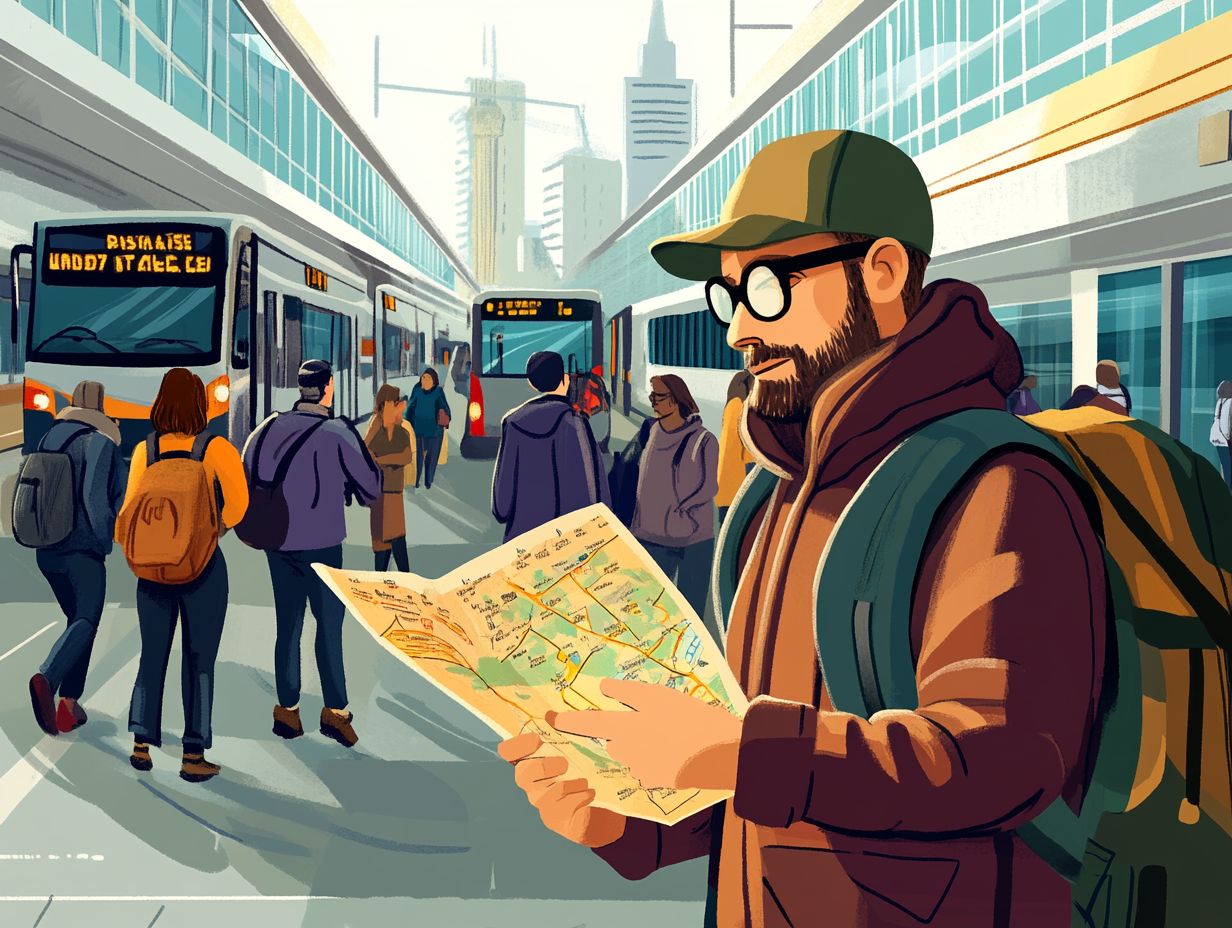
When you travel in Japan, you ll find a wealth of transportation options designed to meet every traveler s needs, from high-speed trains to buses and subways.
These modes of transit not only elevate convenience but also immerse you in the breathtaking landscapes and vibrant cityscapes that define this remarkable country. The Shinkansen, known to many as the bullet train, connects major cities like Tokyo, Kyoto, and Osaka with impressive speed and comfort an essential choice if you re looking to cover long distances swiftly.
Local buses and subways provide an efficient way to navigate urban areas and uncover hidden gems. To make the best choice for your journey, weigh factors such as travel time, frequency, and costs. Don t miss your chance to experience unlimited travel with the Japan Rail Pass; it could significantly enhance your overall experience.
Local Customs and Etiquette
Knowing the local customs in Japan will make your experience more enjoyable and respectful, particularly during dining experiences that often involve chopsticks and specific table manners.
Before meals, always say “Itadakimasu” to express gratitude for the food a small but meaningful gesture. Mastering the proper use of chopsticks is equally important; for example, sticking them upright in a bowl of rice or passing food from one pair of chopsticks to another can be seen as highly disrespectful, as these actions evoke funeral rituals.
Greetings are essential for establishing rapport; bowing is the traditional sign of respect, and a gentle nod or slight bow is appreciated when meeting someone. The honor system common in Japan emphasizes trust and integrity in both business and personal interactions.
Planning Your Route
Effective planning is essential for navigating Japan’s extensive public transit system seamlessly. A solid understanding of maps and timetables will empower you to reach your desired destinations effortlessly, ensuring a smooth and enjoyable journey.
Using Maps and Timetables
Using maps and timetables is essential for travelers in Japan, helping you navigate the intricate public transit system with ease.
Familiarizing yourself with the various forms of transportation trains, subways, and buses can significantly enhance your overall travel experience. For first-time visitors, downloading mobile applications that provide real-time information and route suggestions is highly advisable. This ensures that you can transition smoothly between different modes of transport.
Learning basic Japanese phrases related to navigation can be incredibly beneficial. Understanding Kanji, or Japanese characters used in writing, especially at major stations, will also assist you in deciphering maps and schedules. Keeping an eye on peak travel times can help you avoid crowded trains, making your journey much more comfortable.
Alternative Routes and Transfers
Knowing alternative routes and transfers can enhance your journey through Japan s intricate transportation networks.
With an extensive array of trains, subways, and buses linking cities and regions, understanding your options is immensely beneficial. For instance, popular routes connecting major urban centers may experience congestion during peak hours, leading to unexpected delays. Mastering the art of smoothly transferring between the Shinkansen and local lines saves you time and elevates your overall travel experience.
Utilizing real-time apps keeps you updated on service changes. Purchasing a Japan Rail Pass in advance offers both flexibility and financial savings. Familiarizing yourself with multilingual signage and asking locals for guidance can make navigating transfers a breeze, ensuring that your adventure remains stress-free.
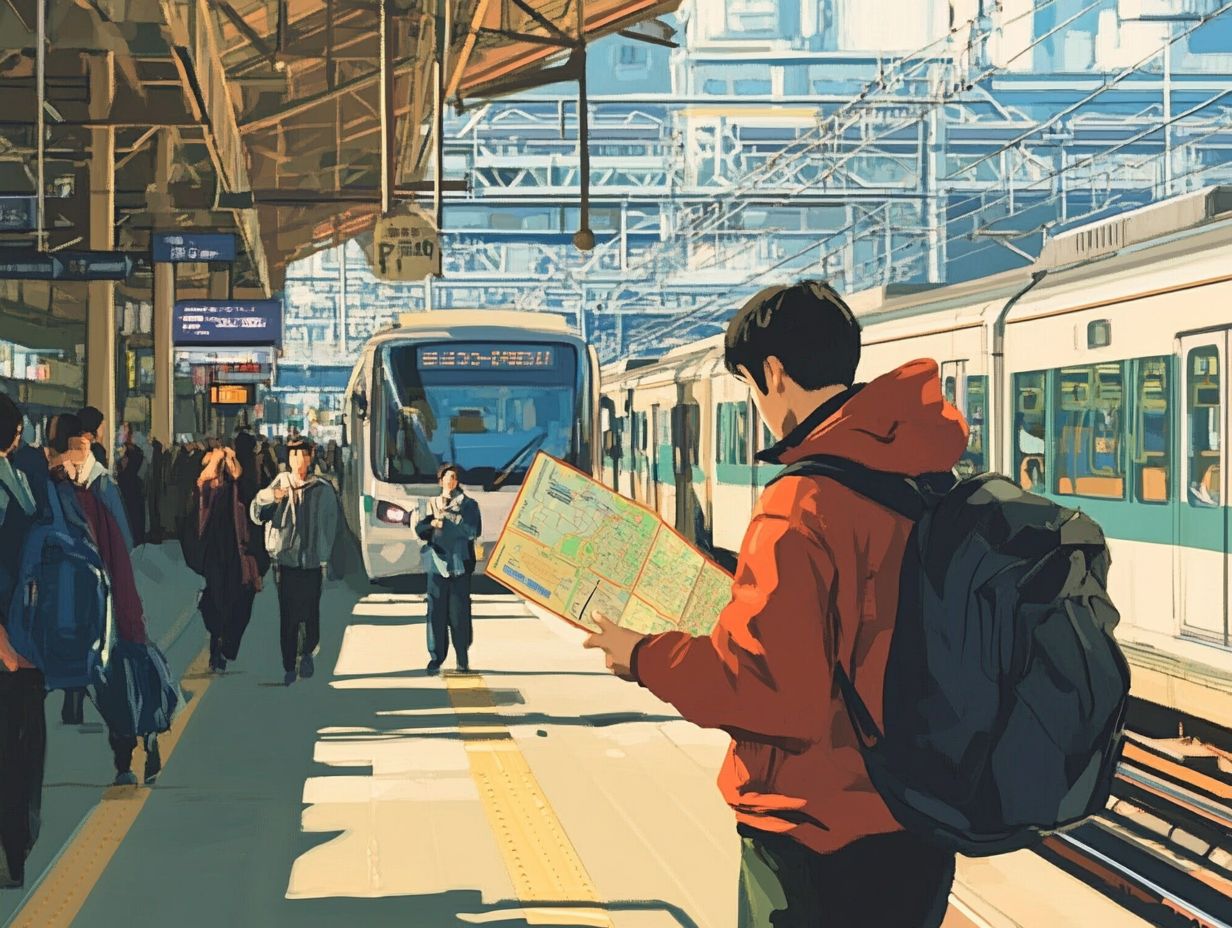
Navigating Japan’s public transport system is a rewarding experience. Arm yourself with essential travel tips that enhance both safety and your ability to overcome language barriers.
Staying Safe and Aware
Staying safe while using public transport in Japan is essential for ensuring that your trip is enjoyable. Remain vigilant about your belongings; crowded trains and buses can make it easy for valuables to slip away unnoticed.
Be prepared for peak times, as public transport can become congested, often requiring a bit of patience. Understanding local customs like waiting in line and keeping noise levels down enhances your travel experience while showing respect for the culture.
Utilizing luggage locks and keeping your essentials close at hand provides peace of mind, ensuring that your journey remains enjoyable and stress-free.
Dealing with Language Barriers
Language barriers in Japan can be a challenge, but learning a few basic Japanese phrases can significantly elevate your travel experience.
Signs and menus predominantly feature Japanese characters, which can lead to confusion. Simple phrases like “Arigato gozaimasu” (Thank you very much) and “Sumimasen” (Excuse me) can foster goodwill and make interactions more pleasant.
Asking for directions using phrases such as “Eigo o hanasemasu ka?” (Do you speak English?) is invaluable as you navigate vibrant streets. By embracing these friendly snippets of the language, you can connect authentically with locals, transforming your journey into something genuinely enriching.
Final Thoughts and Recommendations
Thoughtful planning and preparation can greatly enrich your travel experiences in Japan. Engage with local traditions, savor authentic cuisine, and participate in seasonal festivals.
Exploring bustling urban centers like Tokyo and Kyoto, as well as tranquil rural areas, offers a well-rounded perspective of Japan’s diverse environments. With convenient transportation options like the Shinkansen, getting around the country is a breeze.
Learn basic Japanese phrases to interact warmly with locals. Blend these insights with an open mind and a sense of adventure to create unforgettable memories in this captivating destination!
Start planning your Japanese adventure today! Discover the beauty and excitement that awaits you!
Making the Most of Your Experience
Making the most of your experience in Japan means fully embracing its rich cultural traditions and indulging in its delicious local food. Don’t miss out on the unique experiences waiting for you!
You re encouraged to immerse yourself in the peaceful art of a traditional tea ceremony, offering a fascinating glimpse into the nation s intricate customs. Sampling regional specialties think sushi in Tokyo or okonomiyaki in Osaka can transform a simple meal into a delightful exploration of flavors.
Participating in vibrant cultural festivals, like the iconic Hanami or Gion Matsuri, will elevate your travel experience. Experience the authentic spirit of community and celebration!
By talking to local people and savoring culinary delights, you ll undoubtedly enhance your journey in this captivating land.
Frequently Asked Questions
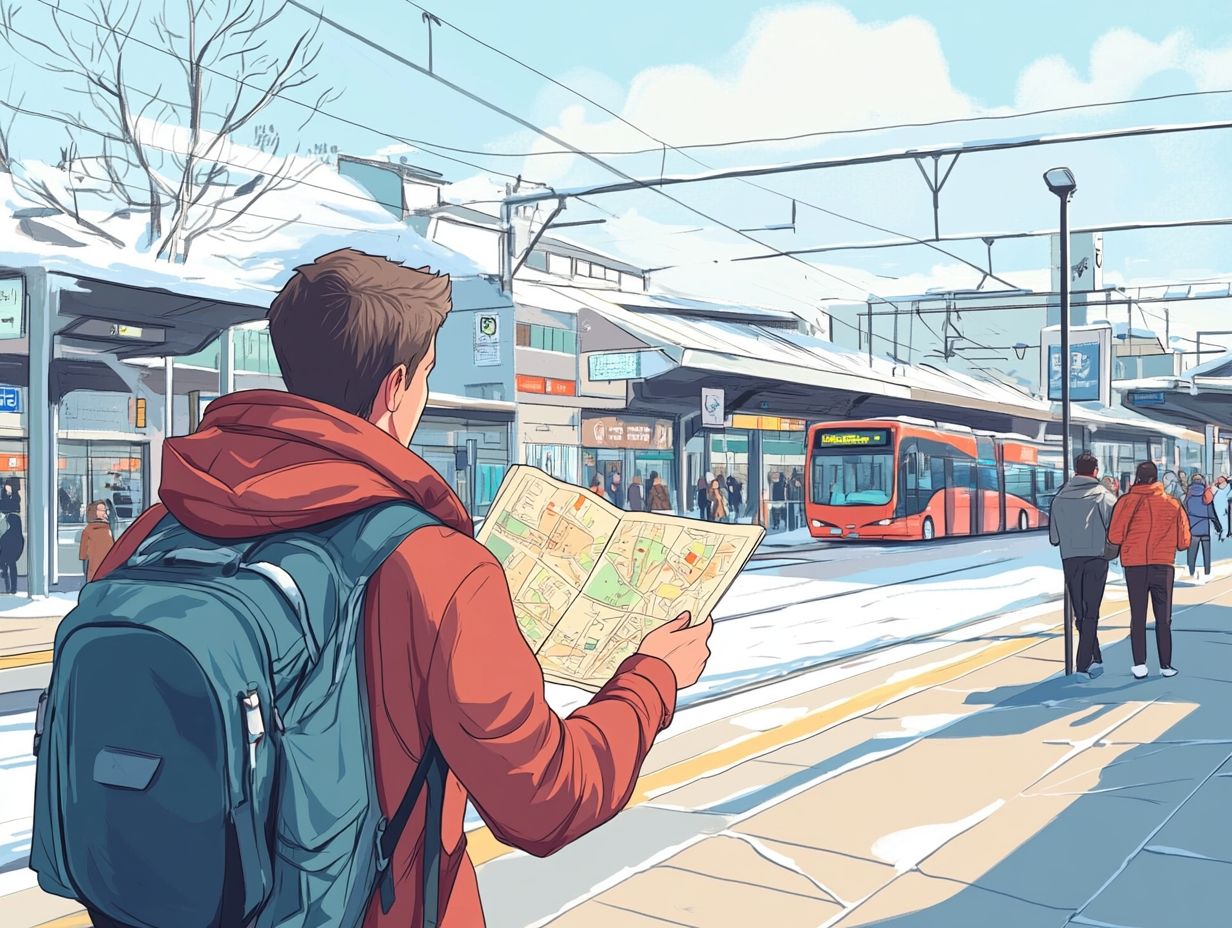
What are the different types of public transport typically available in foreign countries?
In most countries, the common types of public transport include:
- Buses
- Trains
- Subways
- Trams
- Taxis
- Ferries
- Cable cars
- Rickshaws
How can I plan my route using public transport in a foreign country?
You can use a variety of resources such as maps, apps, and websites to plan your route. It is also helpful to ask locals or staff at information centers for recommendations.
What is the best way to purchase tickets for public transport abroad?
Depending on the country, you can purchase tickets at the station, on board the vehicle, or through mobile apps. It is important to have the correct currency and to check for any discounts or passes available.
How do I know which mode of public transport to take?
Consider the distance and time of your journey, as well as the cost and convenience of each mode of transport. It is also helpful to research the local culture and customs to understand the preferred modes of transport.
What should I do if I get lost or miss my stop while using public transport in a foreign country?
Stay calm and ask for help from a fellow passenger or the driver. You can also use your phone or map to navigate your way back or ask for assistance at the next stop or station.
Are there any safety precautions I should take while using public transport abroad?
Be aware of your surroundings and keep your personal belongings close to you. Avoid using public transport late at night or in areas with a high crime rate. It is also recommended to have a backup plan in case of any unexpected delays or disruptions.





